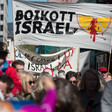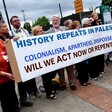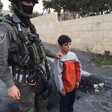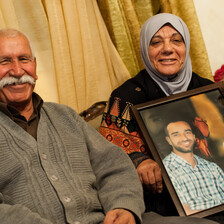The Electronic Intifada 3 January 2018
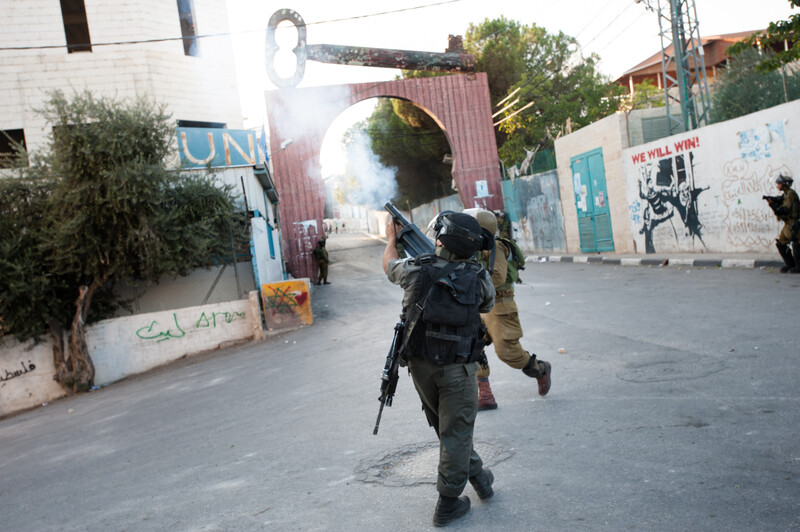
Israeli soldiers fire tear gas in Aida refugee camp in September 2013.
ActiveStillsEvery resident in Aida refugee camp – beside the occupied West Bank city of Bethlehem – may have been exposed to tear gas fired by Israeli forces, according to a new study.
Conducted by University of California researchers, the study notes Israel’s “widespread, frequent and indiscriminate” use of tear gas against Palestinians.
The report cites incidents of tear gas as often as two to three times a week for more than a year, and in some months, almost every day.
In a November speech, Pierre Krähenbühl, the top official with UNRWA, the UN agency for Palestine refugees, said such research suggests that Aida’s residents “are exposed to more tear gas than any other population surveyed globally.”
“They’re shooting everywhere in the camp,” Salah Ajarma, a director at Lajee, the cultural center in Aida, told The Electronic Intifada. “They don’t care about where they shoot.”
The new report used a questionnaire tool developed by the US Centers for Disease Control to survey a sample of 236 Palestinians living in Aida, which hosts 6,400 residents.
Aida – covering just 0.071 square kilometers – has a greater population density than some of the world’s largest cities.
Dangerous to go outside
Members of the team which conducted the study, published by the Human Rights Center at the University of California, Berkeley, witnessed several tear gas incidents while conducting their research. They concluded from their interviews that Israeli forces’ use of tear gas “is not limited to protests or to those at risk of causing violence.”
“Sometimes it’s dangerous to leave the center when there is tear gas outside,” said Ajarma. He recalled a day he confronted soldiers firing tear gas, asking why they were shooting when no children were throwing stones.
“They said, ‘Yesterday they [the children] threw stones and we want to start the tear gas today before the children start.’ So it’s a kind of practice for them,” he added.
The University of California report defines tear gas as a general term for chemical irritants designed for crowd control. The report also notes that newer forms of tear gas have been developed in the recent past that are more potent, last longer and cause more severe pain and injury, as well as being more water resistant.
One child interviewed for the report described the effects of tear gas: “My face burns, I feel dizzy.”
The child added: “It’s hard to breathe. I sneeze. My throat burns. I can’t open my eyes. Sometimes I faint.”
The precise type of gas used by Israeli forces in Aida is unknown. However, the consistent testimonies provided by the camp’s residents suggest that they are being exposed to more potent forms of the weapon.
A health care worker quoted in the report stated: “The old tear gas would be better with some water but [now] that only makes it worse. Obviously, it’s a different chemical.”
Mohammad al-Azza, a journalist and camp resident, told The Electronic Intifada that he agrees that the gas is now stronger than before.
Al-Azza, who also teaches photography at Lajee Center, has first-hand experience of Israeli forces’ use of “crowd control” weapons.
In April 2013, as he was photographing Israeli forces invading the camp, a soldier shot him in the face at close range with a rubber-coated steel bullet that shattered his cheekbone, requiring multiple reconstructive surgeries.
In addition to tear gas, the new report finds that most of Aida’s residents have been exposed to stun grenades, skunk water – a foul-smelling mixture of unknown chemicals fired from high-pressure water cannons – and pepper spray. More than 50 percent of residents interviewed have witnessed the use of rubber-coated steel bullets, while about six percent were “directly witness” to live ammunition being shot.
More than 22 percent of people surveyed said they had been struck directly by a tear gas canister at some point in their lives.
These findings correspond with my own observations. I have witnessed numerous instances of Israeli forces firing tear gas projectiles directly at Palestinian demonstrators in Aida and elsewhere.
Lethal
The new report notes that tear gas and other chemical irritants are banned from use as a weapon of war by the 1992 Chemical Weapons Convention, but not for civil law enforcement “as long as the types and quantities are consistent with such purposes.”
The report concludes, however, that Israeli forces’ use of tear gas “is in discordance with all publicly available international guidelines on how it should be used.”
Aida residents who took part in the survey reported a number of physical effects from tear gas exposure, including asthma, rashes and headaches. It also notes how a 25-year-old woman who took part in the survey had a miscarriage late in the third trimester of pregnancy. A tear gas canister had landed on that woman’s patio several days before she miscarried; she had severe respiratory systems while being exposed to tear gas.
Tear gas has proven to be a lethal weapon on a number of occasions. In April 2014, for example, I attended the funeral of Noha Katamish – a 45-year-old resident of Aida – who died from the effects of tear gas that Israeli forces fired through her living room window.
Salah Ajarma from the Lajee Center described how homes in the camp offer no refuge from the gas. “Sometimes [people] go to their neighbors because they feel it’s safer, but it’s not,” he added.
Many of the psychological impacts of Israeli forces’ use of tear gas stem from its frequency, unpredictability and the inability to escape its effects.
One teenager testified in the report: “We don’t feel safe in our homes. We don’t feel safe anywhere.”
The report states that unpredictability is especially stress-inducing because raids involving tear gas are not always tied to specific incidents, creating “a state of hyper-arousal, fear and worry.”
Made in US
Residents testified that peaceful events, such as a child’s birthday party or family picnics, had been disrupted by tear gas raids, often captured on video.
One interviewee said Israeli soldiers use tear gas “when they are bored, when they want to provoke a clash, or when they want to get into the camp.”
“Sometimes, it feels like they do it just for fun,” said one elderly resident.
As a result, Aida’s residents report high levels of anxiety, depression, fear, sleep disturbance and cognitive dysfunction. According to the report’s authors, these symptoms are consistent with acute stress disorder and post-traumatic stress disorder.
According to one teen surveyed, “We have adapted, but this is not normal. This shouldn’t be how children live.”
While the report underscores the Israeli military forces’ responsibility under international law for the safety of the Palestinian civilians under its control, it also urges UNRWA to respect its mandate to provide practical protection and assistance to refugees in Aida.
“The UN must do something more useful for the people here,” al-Azza from the Lajee Center said.
Teachers and guards employed by UNRWA have asked for specific protocols on how to respond to tear gas attacks, as well as improved facilities, equipment and protective gear.
“The [Israeli] wall is across the street from the school,” said one teacher quoted in the report. “We are the front line.”
Ajarma noted that many families have taken their boys out of the UNRWA school in Aida and sent them elsewhere – or moved out of the camp entirely – because of the constant incursions by Israeli forces.
The US also bears responsibility for the impact of tear gas on Aida. Al-Azza pointed out that like many of the weapons used by the Israeli military, tear gas used in Aida is made in the US.
Shell casings discarded by Israeli forces have frequently been found bearing full contact information for the manufacturer, Combined Systems of Jamestown, Pennsylvania.
In years past, activists have hung “Made in the USA” tear gas grenades and shell casings from trees in Bethlehem’s Manger Square, intentionally juxtaposing them with nearby banners promoting US sponsorship of local holiday light displays.
Activists have often used the Christmas holiday and the camp’s proximity to the Church of the Nativity, believed by many Christians to be the birthplace of Jesus, to focus attention on the present realities faced by Bethlehem-area residents.
Alongside the grenades and shell casings, the activists hung signs reading: “This is the US aid to the Palestinians,” and “US military industrial complex, stop making our Christmas hell by sending us your aid and sending Israel your guns.”
Ryan Rodrick Beiler is a freelance photojournalist and member of the ActiveStills collective. Twitter: @RRodrickBeiler
